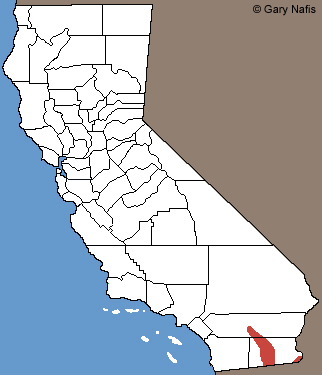|
This species has been introduced into California. It is not a native species.
|
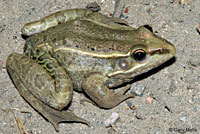 |
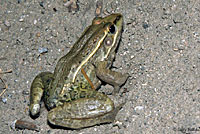 |
 |
| Adult, Riverside County |
Adult, Imperial County |
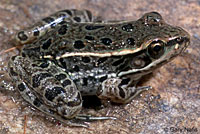 |
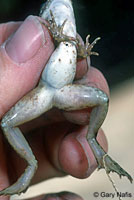 |
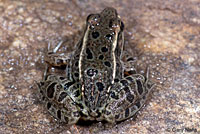 |
| |
Juvenile, Imperial County |
|
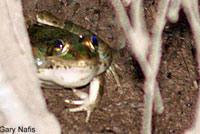 |
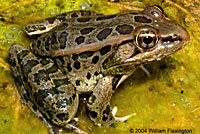 |
 |
A distant male calling at night,
Imperial County.
|
Adult, Imperial County
© William Flaxington
|
Adult, Imperial County
© Chris Gruenwald |
| |
|
|
| Rio Grande Leopard Frogs From Outside California |
 |
 |
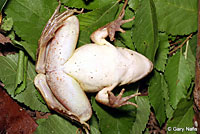 |
Adult in defensive position,
Travis County, Texas |
Adult, Willacy County, Texas |
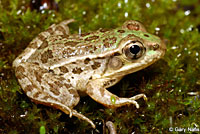 |
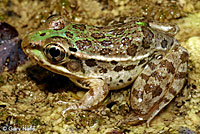 |
 |
| Juvenile, Williamson County, Texas |
Adult, Hidalgo County, Texas |
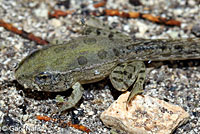 |
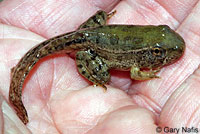 |
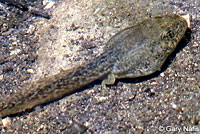 |
| |
Tadpoles, Bandera County, Texas
|
|
| |
|
|
| Rio Grande Leopard Frog Habitat |
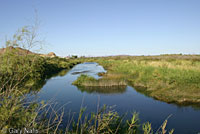 |
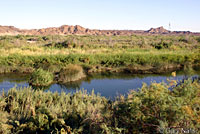 |
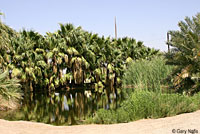 |
| Habitat, Colorado River, Imperial County |
Habitat, Colorado River, Imperial County |
Habitat, hot Springs, Imperial County
|
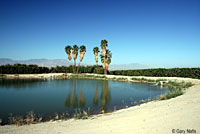 |
 |
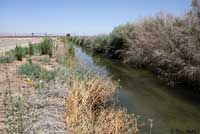 |
| Irrigation pond habitat, Riverside County |
Habitat, agricultural drain,
Imperial County
|
Habitat, agricultural drain,
Imperial County
|
| |
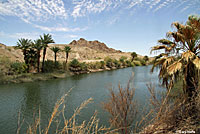 |
|
| |
Habitat, Colorado River, Imperial County
|
|
| |
|
|
| Short Videos |
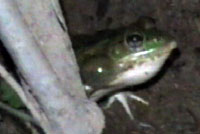 |
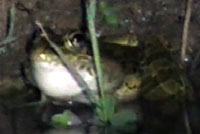 |
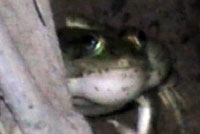 |
A male Rio Grande Leopard Frog calls at night from the edge of an agricultural canal in Imperial County, using his throat sack as well as pouches on the side of the neck to produce a variety of sounds. Another leopard frog joins in and they are both accompanied by an
American Bullfrog. |
A male Rio Grande Leopard Frog calls at night in Imperial County, accompanied by insects. |
A male Rio Grande Leopard Frog calls at night from the edge of an agricultural canal in Imperial County, using his repertoire of grunts and chuckles, then he is accompanied by another leopard frog and several American Bullfrogs. |
|
|
|
|
Description |
| |
| Size |
Adults are 2.25 - 4.5 inches long from snout to vent (5.7 - 11.4 cm). (Stebbins, 2003)
|
| Appearance |
| A medium-sized slender frog with a narrow head and long legs. |
| Color and Pattern |
Coloring is pale green, grayish brown, olive.
Dorsal spots are light and not clearly edged with light color.
Thighs have dark reticulations.
Prominent dorsolateral folds turn inward in front of the groin.
A light-colored stripe runs along the jaw but fades or disappears in front of the eye.
The underside is dusky colored and mottled with dark color.
The groin and underside of the rear legs are yellowish. |
| Male/Female Differences |
The base of a male's thumb is swollen and dark.
Males have a pair of external vocal sacs, which are not always visible.
|
| Comparison with Lowland Leopard Frog - Rana yavapaiensis |
"Lowland Leopard Frog is less likely to have greenish coloration and conspicuous dark reticulated thigh pattern."
(Stebbins, 2003)
|
| Life History and Behavior |
| Activity |
Typically a stream frog. Highly aquatic, seldom found away from water, but can tolerate fairly dry conditions by burrowing. Can be active at day and more likely at night. Active all year long except in periods of low temperature.
Frogs shelter under rocks and in vegetation at the edge of streams.
Tadpoles are adapted to swimming in streams and can swim against a current.
Tadpoles will gulp air at the water surface to increase their oxygen uptake. |
| Defense |
| These frogs jump into the water and swim away or swim into dense vegetation when threatened. |
Territoriality
|
| Males make chuckling calls during breeding to announce their territory. |
| Longevity |
| Not known. |
| Voice (Listen) |
The call is a loud, short, low-pitched trill or rattle, lasting less than a second, given singly or in rapid sequences of 2 - 3 trills.
Males call at night with paired external vocal sacs. |
| Diet and Feeding |
Feeds on a wide variety of terrestrial and aquatic prey, mostly invertebrates, and sometimes small frogs including other leopard frogs..
Typical of most frogs, the prey is located by sight, then a large sticky tongue is used to catch the prey and bring it into the mouth to eat.
Tadpoles feed on algae, inorganic particles, an diatoms. |
| Reproduction |
Reproduction is aquatic.
Fertilization is external, with the male grasping the back of the female and releasing sperm as the female lays her eggs.
The reproductive cycle is similar to that of most North American Frogs and Toads, but in warm climates breeding is continuous and is not dependent on seasonal temperature changes and rainfall or snowmelt. Breeding and egg-laying typically occurs in water after rainfall at almost any time of the year. In the California desert areas that these frogs have colonized, breeding probably takes place nearly all year, with a lull from November through January.
Males call from locations in or next to water to advertise their fitness to competing males and to females. Males and females pair up in amplexus in the water where the female lays her eggs as the male fertilizes them externally. The adults leave the water and the eggs hatch into tadpoles which feed in the water and eventually grow four legs, lose their tails and emerge onto land where they disperse into the surrounding territory. |
| Eggs |
Eggs are laid in masses which are attached to submerged vegetation a few inches below the surface.
500 to 1,200 eggs are laid in a clutch. (Stebbins & McGinnis, 2012)
|
| Tadpoles and Young |
Tadpoles have been observed overwintering in Texas and Arizona.
Since breeding occurs over many months, newly metamorphosed juveniles and tadpoles of different sizes are usually found at a location. Juveniles utilize the same habitat as adults.
|
| Hybrids |
Some hybridization occurs with the Plains Leopard Frog - Lithobates blairi, in north-central Texas. (Stebbins, 2003)
|
| Habitat |
In California, occurs in drainage ditches, irrigation canals, artificial irrigation ponds, sumps, desert hot springs, and along the lower Colorado river. Elsewhere, the species inhabits a variety of sources of permanent water - streams, rivers, artificial ponds, cattle tanks, ditches, natural wells, and at sources of permanent water in tropical forest.
|
| Geographical Range |
Native to Texas, New Mexico, south through Mexico into central America.
Recently introduced into extreme southwest Arizona and California in the Imperial Valley and the lower Colorado River area of Imperial and Riverside Counties. Range is expanding through dispersal in agricultural canals. This frog is continuing to expand its range in the Imperial Valley and can now be found north of the Salton Sea.
According to Jennings and Fuller in their 2004 report on the distribution of leopard frogs in California "Rio Grande leopard frogs seem to have been accidentally introduced into the lower Colorado River near Yuma, Arizona, via one or more fish plants from either Texas or New Mexico between 1965 and 1971 (Platz et al. 1990). Since 1981, the species has expanded its range and has been taken in agricultural areas along the lower Colorado River (Clarkson and Rorabaugh 1989) and in the Imperial Valley (Jennings and Hayes 1994)."
|
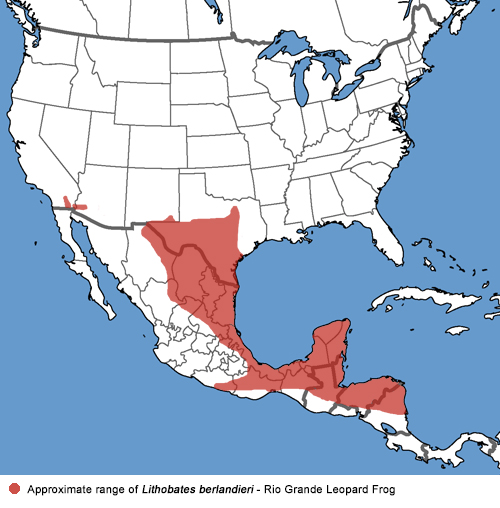 |
| Elevational Range |
Found at elevations from below sea level to
about 5,000 ft. (Stebbins, 2003)
Most populations in California are close to sea level.
|
| Notes on Taxonomy |
In 2006, Frost et al divided North American frogs of the family Ranidae into two genera, Lithobates and Rana. Rana is still used in many existing references for this species.
---------------------------------------------------------------------------------------------------------------------------------------------------------------------
Nicholson, K. E. (ed.). 2025 SSAR Scientific and Standard English Names List comment:
" Geographic variation is not well documented and relationships with extralimital Mexican forms will require considerable morphological and nDNA work to resolve."
---------------------------------------------------------------------------------------------------------------------------------------------------------------------
Alternate and Previous Names (Synonyms)
Rana berlandieri - Rio Grande Leopard Frog (Stebbins 1985, 2003, Stebbins & McGinnis 2012)
Rana pipiens - Leopard Frog (Stebbins 1954, 1966)
Rana pipiens berlandieri (Wright and Wright 1949)
Rana pipiens - Leopard Frog (Storer 1925)
Rana pipiens (Schreber 1782)
|
| Conservation Issues (Conservation Status) |
| It appears that the introduction of the Rio Grande Leopard Frog has been responsible for the disappearance of the native Lowland Leopard Frog in southeastern California, although there may be other causes for the decline.
|
|
| Taxonomy |
| Family |
Ranidae |
True Frogs |
Rafinesque, 1814 |
| Genus |
Lithobates |
American Water Frogs |
Fitzinger, 1843 |
| Species |
berlandieri |
Rio Grande Leopard Frog
|
Baird, 1854 |
|
Original Description |
Baird, 1859 - Report U.S. Mex. Bound. Survey, Vol. 2, Pt. 2, Rept., p. 27, pl. 36, figs. 7-10
from Original Description Citations for the Reptiles and Amphibians of North America © Ellin Beltz
|
|
Meaning of the Scientific Name |
Lithobates - Greek - Litho = a stone, bates = one that walks or haunts
berlandieri - honors Berlandier, Jean Louis
Taken in part from Scientific and Common Names of the Reptiles and Amphibians of North America - Explained © Ellin Beltz
James Kaye has written a novel about Berlandier's explorations in Texas in 1828: Kaye, James. Berlandier - A French Naturalist on the Texas Frontier.
Trafford Publishing, 2010.
|
|
Related or Similar California Frogs |
Lithobates pipiens
Lithobates catesbeianus
Lithobates yavapaiensis
Rana draytonii
Rana aurora
Rana boylii
Rana cascadae
Rana pretiosa
Rana muscosa
|
|
More Information and References |
California Department of Fish and Wildlife
AmphibiaWeb
Jennings, Mark R., and Michael M. Fuller. 2004. Origin and distribution of leopard frogs, Rana pipiens complex, in California. California Fish and Game 90(3):119-139.
Hansen, Robert W. and Shedd, Jackson D. California Amphibians and Reptiles. (Princeton Field Guides.) Princeton University Press, 2025.
Stebbins, Robert C., and McGinnis, Samuel M. Field Guide to Amphibians and Reptiles of California: Revised Edition (California Natural History Guides) University of California Press, 2012.
Stebbins, Robert C. California Amphibians and Reptiles. The University of California Press, 1972.
Flaxington, William C. Amphibians and Reptiles of California: Field Observations, Distribution, and Natural History. Fieldnotes Press, Anaheim, California, 2021.
Nicholson, K. E. (ed.). 2025. Scientific and Standard English Names of Amphibians and Reptiles of North America North of Mexico, with Comments Regarding Confidence in Our Understanding. Ninth Edition. Society for the Study of Amphibians and Reptiles. [SSAR] 87pp.
Samuel M. McGinnis and Robert C. Stebbins. Peterson Field Guide to Western Reptiles & Amphibians. 4th Edition. Houghton Mifflin Harcourt Publishing Company, 2018.
Stebbins, Robert C. A Field Guide to Western Reptiles and Amphibians. 3rd Edition. Houghton Mifflin Company, 2003.
Behler, John L., and F. Wayne King. The Audubon Society Field Guide to North American Reptiles and Amphibians. Alfred A. Knopf, 1992.
Robert Powell, Roger Conant, and Joseph T. Collins. Peterson Field Guide to Reptiles and Amphibians of Eastern and Central North America. Fourth Edition. Houghton Mifflin Harcourt, 2016.
Powell, Robert., Joseph T. Collins, and Errol D. Hooper Jr. A Key to Amphibians and Reptiles of the Continental United States and Canada. The University Press of Kansas, 1998.
American Museum of Natural History - Amphibian Species of the World 6.2
Bartlett, R. D. & Patricia P. Bartlett. Guide and Reference to the Amphibians of Western North America (North of Mexico) and Hawaii. University Press of Florida, 2009.
Elliott, Lang, Carl Gerhardt, and Carlos Davidson. Frogs and Toads of North America, a Comprehensive Guide to their Identification, Behavior, and Calls. Houghton Mifflin Harcourt, 2009.
Lannoo, Michael (Editor). Amphibian Declines: The Conservation Status of United States Species. University of California Press, June 2005.
Storer, Tracy I. A Synopsis of the Amphibia of California. University of California Press Berkeley, California 1925.
Wright, Albert Hazen and Anna Wright. Handbook of Frogs and Toads of the United States and Canada. Cornell University Press, 1949.
Davidson, Carlos. Booklet to the CD Frog and Toad Calls of the Pacific Coast - Vanishing Voices. Cornell Laboratory of Ornithology, 1995.
|
|
|
The following conservation status listings for this animal are taken from the July 2025 State of California Special Animals List and the July 2025 Federally Listed Endangered and Threatened Animals of California list (unless indicated otherwise below.) Both lists are produced by multiple agencies every year, and sometimes more than once per year, so the conservation status listing information found below might not be from the most recent lists, but they don't change a great deal from year to year.. To make sure you are seeing the most recent listings, go to this California Department of Fish and Wildlife web page where you can search for and download both lists:
https://www.wildlife.ca.gov/Data/CNDDB/Plants-and-Animals.
A detailed explanation of the meaning of the status listing symbols can be found at the beginning of the two lists. For quick reference, I have included them on my Special Status Information page.
If no status is listed here, the animal is not included on either list. This most likely indicates that there are no serious conservation concerns for the animal. To find out more about an animal's status you can also go to the NatureServe and IUCN websites to check their rankings.
Check the current California Department of Fish and Wildlife sport fishing regulations to find out if this animal can be legally pursued and handled or collected with possession of a current fishing license. You can also look at the summary of the sport fishing regulations as they apply only to reptiles and amphibians that has been made for this website.
This frog is not included on the Special Animals List, meaning there are no significant conservation concerns for it in California according to the Dept. of Fish and Game.
|
| Organization |
Status Listing |
Notes |
| NatureServe Global Ranking |
|
|
| NatureServe State Ranking |
|
|
| U.S. Endangered Species Act (ESA) |
|
|
| California Endangered Species Act (CESA) |
|
|
| California Department of Fish and Wildlife |
|
|
| Bureau of Land Management |
|
|
| USDA Forest Service |
|
|
| IUCN |
|
|
|
|
|
